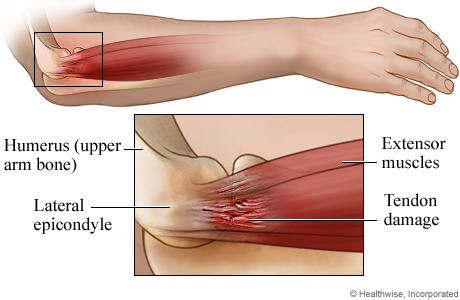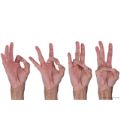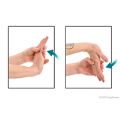Our Health Library information does not replace the advice of a doctor. Please be advised that this information is made available to assist our patients to learn more about their health. Our providers may not see and/or treat all topics found herein. Tennis elbow, also known as lateral epicondylitis or epicondylopathy, occurs when there is tendon damage at the elbow where some of the forearm and hand muscles connect to the upper arm bone. Most of the time, tennis elbow is caused by overuse. You probably got it from doing activities where you twist your arm over and over. This can stress the tendon, causing tiny tears that lead to pain over time. A direct blow to the outer elbow can also cause tendon damage. Tennis elbow causes pain on the outer part of the elbow. The pain usually starts gradually and may go away within 24 hours after an activity. Over time, it may take longer for the pain to go away. You may start to feel pain during everyday activities, like lifting a jug of milk. Your doctor will check your elbow and ask questions about the elbow problem, your daily activities, and past injuries. You probably won't need to have an X-ray. But you may need an X-ray or other tests if your symptoms don't get better with treatment. Most cases of tennis elbow respond to rest, ice, rehab exercises, pain medicine, and using a counterforce brace. You will probably feel better in a few weeks, but it may take 6 to 12 months for the tendon to heal. Surgery is rarely needed. Health Tools help you make wise health decisions or take action to improve your health. The best way to prevent tennis elbow is to stretch and strengthen your arm muscles so that they are flexible and strong enough for your activities. Other ways to prevent tennis elbow include: Tennis elbow symptoms usually start gradually. The main symptom is pain. It may start with a dull aching or soreness on the outer part of the elbow that goes away within 24 hours after an activity. Over time, it may take longer for the pain to go away. You may start to feel pain with any movement, even during everyday activities, such as lifting a jug of milk. You may even have pain when you aren't using your elbow. Other parts of the arm, shoulder, and neck may also be sore. This is because you are using different movements and muscles to make up for the loss of elbow strength and movement. Call your doctor now if you had an injury to your elbow and: Call your doctor if you have: Watchful waiting is a wait-and-see approach. You and your doctor watch your symptoms to see if your health improves on its own. If it does, no treatment is needed. If your symptoms don't get better or they get worse, then it's time to take the next treatment step. Home treatment often helps mild tennis elbow pain. You may want to try resting the elbow and applying ice or heat several times a day for 1 to 2 weeks before you call your doctor. To diagnose tennis elbow, a doctor will examine your elbow and ask questions about the elbow problem, your daily activities, and past injuries. You probably won't need to have an X-ray. But you might have one to help rule out other things that could be causing the pain. If your symptoms don't get better with treatment, you might need other tests. You can start treating tennis elbow at home right away. It includes: With early rest and treatment, an injured tendon is likely to heal with scar tissue and maximum strength. Most cases of tennis elbow respond to treatment. You will probably feel better in a few weeks, but it may take 6 to 12 months for the tendon to heal. If your symptoms don't go away, your doctor may suggest: Physical rehabilitation (rehab) is combined with resting the tendon. It can help restore flexibility and build muscle strength. Rehab helps heal injured tendons and muscles. And it helps prevent further injury. Rehab is also needed after surgery for tennis elbow. A physical rehab program includes: If you have tennis elbow, try these simple tips to reduce pain and start tendon healing. You can help prevent further injury by making your arm muscles stronger. This allows your tendon to heal. Stop any activity that you think may be causing your elbow pain and soreness. You may have to avoid the activity for weeks to months, depending on how severe the tendon damage is. As soon as you notice pain, use ice or cold packs for 10 to 15 minutes at a time, several times a day. Always put a thin cloth between the ice and your skin. Keep using ice as long as it relieves pain. You can try heat, or alternating heat and ice, after the first 3 days. Do what works for you. Wear a counterforce brace during activities that require grasping or twisting arm movements. The brace is a strap that you wear around your forearm just below your elbow. It may spread pressure throughout the arm instead of putting it all on the tendon. These braces aren't a substitute for rehab exercises. This may help ease pain and reduce swelling in your wrist or forearm. Nonsteroidal anti-inflammatory drugs (NSAIDs) include aspirin (such as Bayer), ibuprofen (such as Advil), and naproxen (such as Aleve). They help reduce pain and inflammation. NSAIDs come in pills and in a cream that you rub over the sore area. Acetaminophen (such as Tylenol) can also help with pain. Be safe with medicines. Read and follow all instructions on the label. They may help keep your tendons from getting stiff. Examples include finger-thumb opposition and wrist flexor stretches. If you have any pain, stop the exercises. When your pain is gone, start doing stretching and strengthening exercises. Then increase these exercises bit by bit. Learn the correct techniques and which equipment is best for your activities. Current as of: July 24, 2025 Author: Ignite Healthwise, LLC Staff Current as of: July 24, 2025 Author: Ignite Healthwise, LLC Staff Clinical Review Board This information does not replace the advice of a doctor. Ignite Healthwise, LLC disclaims any warranty or liability for your use of this information. Your use of this information means that you agree to the Terms of Use and Privacy Policy. Learn how we develop our content. To learn more about Ignite Healthwise, LLC, visit webmdignite.com. © 2024-2025 Ignite Healthwise, LLC.Tennis Elbow
Condition Basics
What is tennis
elbow?

What causes
it?
What are the
symptoms?
How is it
diagnosed?
How is tennis elbow
treated?
Health Tools
Prevention
Learn more
Symptoms
When to Call a Doctor
Watchful waiting
Exams and Tests
Learn more
Treatment Overview
Physical rehab for tennis
elbow
Learn more
Self-Care
Learn more
Related Information
Credits
Clinical Review Board
All Ignite Healthwise, LLC education is reviewed by a team that includes physicians, nurses, advanced practitioners, registered dieticians, and other healthcare professionals.
All Ignite Healthwise, LLC education is reviewed by a team that includes physicians, nurses, advanced practitioners, registered dieticians, and other healthcare professionals.
Our Health Library information does not replace the advice of a doctor. Please be advised that this information is made available to assist our patients to learn more about their health. Our providers may not see and/or treat all topics found herein. Current as of: July 24, 2025 Author: Ignite Healthwise, LLC Staff Clinical Review BoardTennis Elbow
All Ignite Healthwise, LLC education is reviewed by a team that includes physicians, nurses, advanced practitioners, registered dieticians, and other healthcare professionals.






